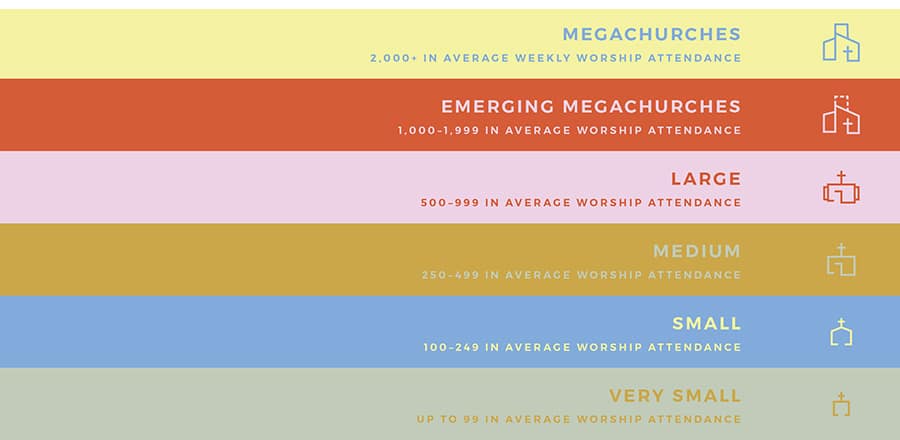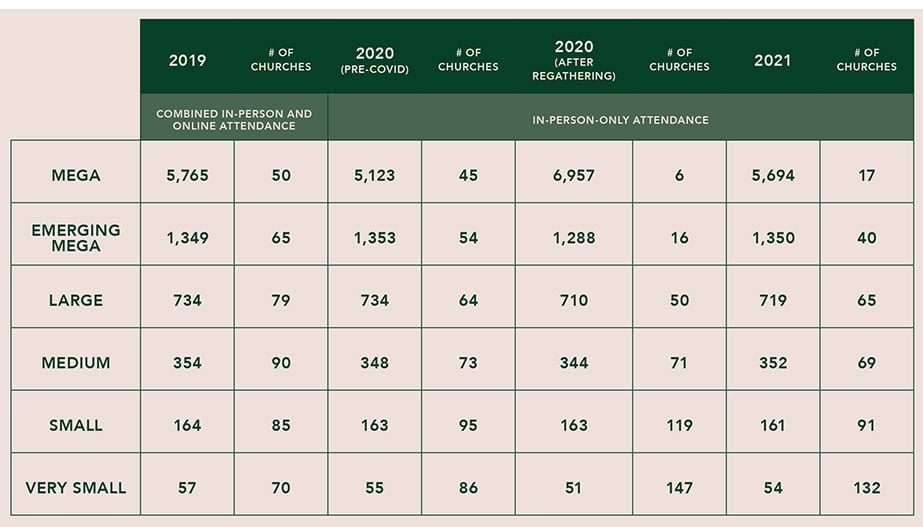By Kent E. Fillinger
After a roller-coaster year in 2020 with churches closing and reopening for in-person worship—sometimes multiple times—2021 provided a respite from that wild ride. The average Christian church in our survey held in-person worship services on 37 weekends in 2020 but increased that to 51 weekends last year. Two-thirds of churches held in-person services every weekend in 2021.
National surveys across various denominations found that 73 percent of prepandemic, in-person worship attendees returned by the fall of 2021. Likewise, our survey of more than 400 Christian churches and churches of Christ found that the average congregation was at approximately 72 percent of their pre-COVID-19, in-person worship attendance average last year.
Small and very small churches had the best rebounds; they recovered three-fourths of their pre-COVID-19 in-person attendance in 2021. Megachurches, at 61 percent, have been the slowest to recover in-person attendance. Thirty-seven churches (9 percent of those surveyed) reported their 2021 in-person attendance had recovered entirely or that they had grown during the pandemic.
_ _ _
Download the 2021_Church_Report
_ _ _
Worship Attendance Trends
The 2020 Faith Communities Today survey of 15,278 religious congregations across the United States found a median decline in attendance of 7 percent between 2015 and 2020. The survey, completed just before the coronavirus outbreak, found that half of the country’s estimated 350,000 religious congregations averaged 65 or fewer people on any given weekend. That’s a precipitous drop from a median church attendance of 137 people in 2000, the first year data was gathered.
Over the past three years in Christian churches and churches of Christ, worship attendance trends have remained mostly stable despite a global pandemic. The chart shows the annual worship attendance for each church size category.
The attendance figures listed for both 2020 and 2021 include only in-person worship attendance. Our 2019 survey asked churches to report a combined in-person and online attendance figure, which is what is listed below. That survey also asked churches what percentage of their total attendance was comprised from online viewers; we found that the overall online attendance average was 8 percent of the total attendance.
In-Person or Online Worship?
Valley Real Life (Greenacres, Washington) told us they asked their congregation, “What is it that you can’t or don’t experience well online that you get onsite?” The top response was children’s ministry, followed by worship and then relationships. The church said they’re excited that if they do those three things really well, God will use those things to draw people to himself.
In that same spirit, Christian Standard decided to focus on in-person worship attendance for our 2021 special report. (See “2021 Church Report” and this issue’s Letter from the Editor for more information.)
Our survey did gather online attendance data, however; I will dissect emerging trends for online worship attendance in my Metrics column in our next issue.
This shift in focus to in-person attendance directly impacts how churches are classified based on our standard church-size categories. For example, only 17 churches last year reported average in-person worship attendance of 2,000 or more, so the number of megachurches we are listing decreased considerably. If online attendance were added to the in-person numbers, 45 churches would be in the megachurch category.
Therefore, the positioning of the 414 churches listed in the accompanying attendance charts will look different than in previous years, even though most of the same churches participated in our survey again this year. The shifts were not as dramatic in the very small to large churches because online attendance is less of a factor in those churches’ total reported attendance.
Baptisms
The total number of baptisms in 2021 increased by 51 percent compared with 2020 (20,387 vs. 13,502). Of course, in 2020 churches were closed for in-person worship much of the year. Now the bad news; total baptisms in 2021 were still far fewer than in the two years leading up to the pandemic. Surveyed churches reported 32,139 baptisms in 2019 and 31,269 in 2018 (in all three of these years, a similar number of churches reported). Ten percent of churches reported no baptisms in 2021.
A better metric for evaluating baptisms is the “baptism ratio,” which reflects the number of baptisms per 100 people in average attendance. When calculating baptism ratios based only on in-person worship attendance, megachurches, emerging megachurches, large, and very small churches had record years.
Megachurches had the highest baptism ratio, with 9.1 baptisms per 100 in average in-person attendance. Second highest were emerging megachurches, at 8.5. Small churches had the lowest baptism ratio, 5.8. Of course, when calculating baptism ratios using combined in-person and online attendance figures, the ratios plummeted. For example, the megachurch baptism ratio dropped from 9.1 to only 4.6 with online attendance included.
Financial Outlook
While 69 percent of the churches surveyed reported fiscal year 2020 giving met or exceeded 2019 giving, financial results were even better last year, with 77 percent of churches saying 2021 giving met or exceeded 2020. For the 23 percent of churches that saw giving decrease in 2021, most of those churches reported only 1 to 9 percent declines.
Additionally, 78 percent of the churches surveyed said overall giving met or exceeded their ministry budgets in 2021. It was the best budget performance for every church size category over the past 11 years (except for megachurches, which saw a slightly better budget performance—by 2 percentage points—in fiscal year 2018).
Ministry spending increased for almost half (46 percent) of the churches last year. Megachurches were the most likely to report increased ministry spending (63 percent), while very small churches were the least likely (33 percent). Ministry spending remained the same in 30 percent of the churches surveyed, while 24 percent decreased their spending.
In another sign of financial health, churches continued to increase their cash reserves last year. In 2018, we first asked churches to report the number of weeks of operating expenses they had on hand; it averaged 9.8 weeks of operational reserves that year. Since then, the number has increased steadily each year. In 2021, churches averaged 14 weeks of cash reserves, and one-third of the churches reported having 21 weeks or more of operational reserves.
An overwhelming majority of churches (86 percent) reported having an “optimistic” financial outlook, 13 percent were “uncertain,” and only 1 percent were “pessimistic.”
Top Ministry Concerns
We asked churches, “What are your top two concerns about the future of your local church ministry?” Among the hundreds of responses, these were the top concerns:
- Discipleship—making disciples who make disciples
- Evangelism—reaching the lost and sharing our faith
- Leadership Development—the need for new, more, and younger leaders
- Financial Concerns—giving, debt, and inflation
- Ongoing Impact of COVID-19—adapting to a new ministry model post-COVID
- Staffing—finding and keeping good staff
- Community Outreach—impacting the local community by meeting needs
- Congregational Aging—church members aging and dying
- People Not Returning In-Person—members missing in action or watching online
- Commitment Issues—the lack of commitment from church members to worship, serve, lead, and give
- Young Families—attracting and keeping young families
- Succession Planning—senior ministers transitioning and preparing to retire in the next few years
Causes for Celebration
We also asked churches to identify two aspects of ministry for which they are most proud or excited. Among the responses—which we classified into 90 categories—these were the top 10:
- Community Outreach Ministries—serving local needs through various partnerships and programs (More than 100 churches listed this as a cause for celebration, which was more than double the number of responses for all but “generosity.”)
- Generosity—the faithful giving of the church
- Missions—involvement and giving to mission initiatives
- Children’s/Family Ministry
- Youth/Student Ministry
- Discipleship Initiatives—creating discipleship pathways to encourage disciple-making
- Growth/New Families Attending Church
- Ministry Staff and Culture
- Weekend Worship Services
- Preaching/Teaching—solid biblical approach
Tied for the 11th position (each missing the top 10 by single votes) were “Evangelism/Reaching the Lost” and “Online Ministry.”



As I looked over the list of churches it became readily apparent that many churches, for whatever reason, did not choose to be listed. My son’s church, Parkview in Orland Park, Illinois, is one. Community Christian in the Chicago area is another. I plan to ask my son why they did not respond. It is a confusing time, I realize. And I am of the old school where things were a little more closely defined. One church I know a little about is Hillside church in Amarillo. My brother-in-law, Roy Wheeler, led that congregation to become one of the largest churches in Texas. It was called Paramount Terrace church during those years. After he retired the church continued to grow and now has satellite locations all over northwest Texas and even into New Mexico! But they choose not to be listed because they don’t want to appear proud, or something like that. So what is the new normal? I guess I believe that what Kent is trying to do is not going to work anymore. The tight Christian Church fellowship that I served during my life-time no longer exists. And whether that is good or bad remains to be seen. But God is still in control!